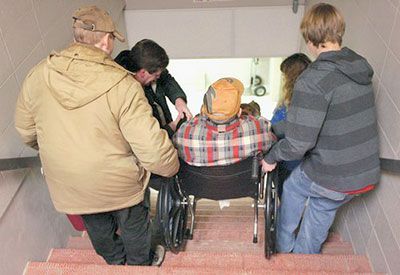What to look for in an Evacuation Chair.

The scenario shown in picture is totally unacceptable to both the rescuers and the person being manhandled in such an undignified and dangerous way. Evac+Chair was the breakthrough that made such methods both obsolete and unacceptable.
First, make sure it’s light, strong and simple to operate. Superfluous braking systems, overweight construction and multiple part lists do not make an emergency tool that can be counted on. Weight and complexity are to be avoided.
Evacuation equipment may well need to be carried to where it’s needed most. Up a flight of stairs, down the hall to a bedroom, to an accessible fire stair… it can be difficult to store equipment exactly where it will be needed. Therefore be sure it’s light enough to be carried and easily positioned. Ten kilograms is doable, 20kg is an arm-wrenching struggle. An added benefit here is that “light” translates into “speed” for getting it to where it’s needed.
Evacuating an individual down fire stairs requires “controlled descent” - speed needs to match traffic flow. “Polymatic Traction”TM is the self- regulating speed governor feature of EVAC+CHAIR that enables the operator to speed up, slow down or stop on the stairs with smooth assurance and ease during the chaotic flow of evacuation.
Since its introduction in 1982, EVAC+CHAIR® has gone through 5 major design revisions with minimal weight increase and little added complexity for major evolutionary improvement.
For these reasons, EVAC+CHAIR®has remained the gold standard for building evacuation of the disabled since 1982.
Be aware of some cheaper look alike chairs now being distributed in NZ. They can be DANGEROUS. See our pages "Beware of Lookalikes" as well as "Manufacturing Standards"

